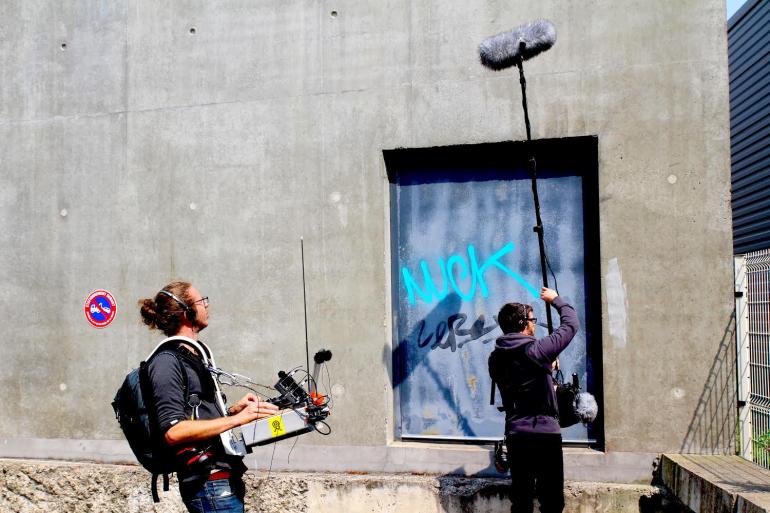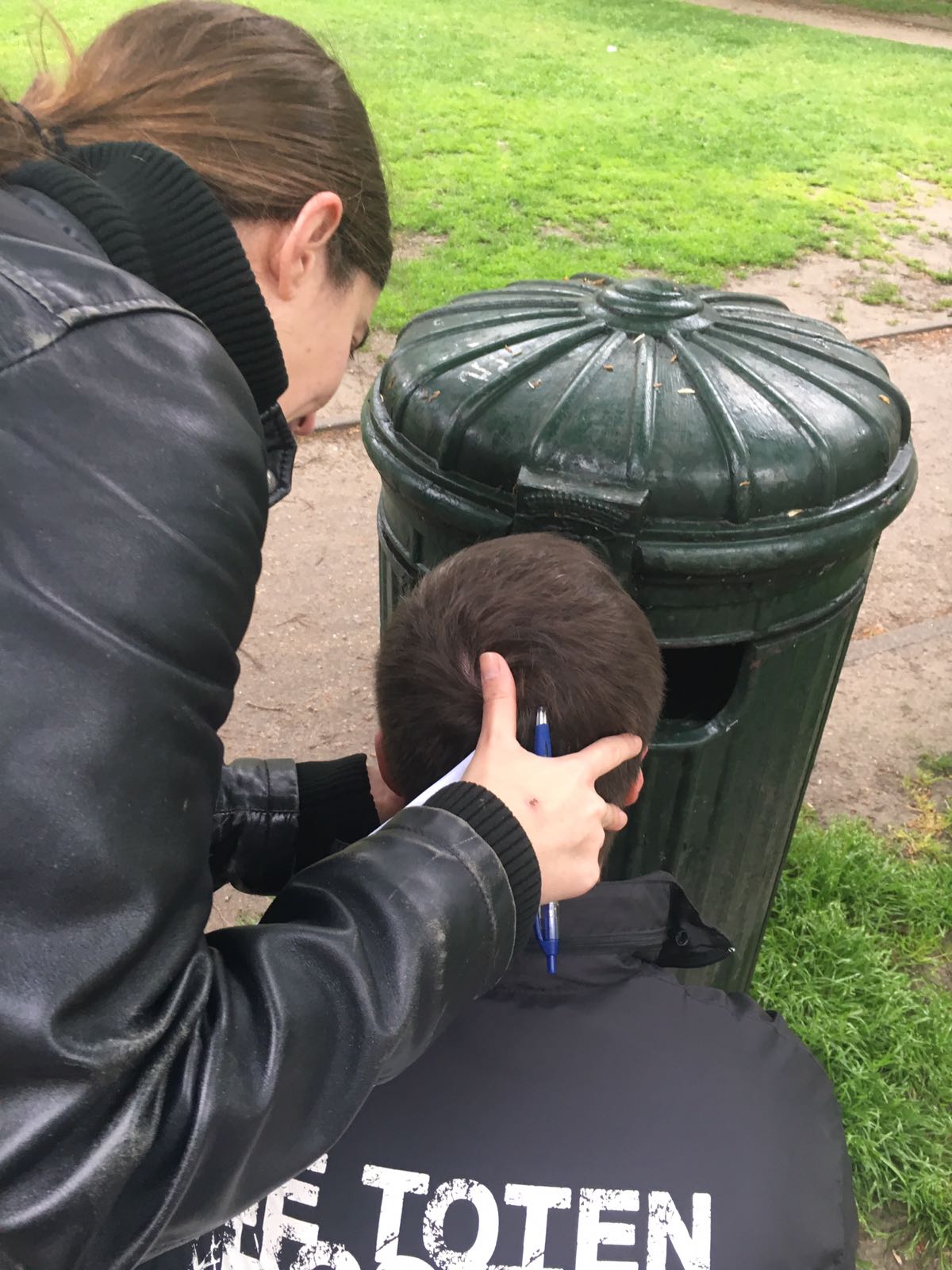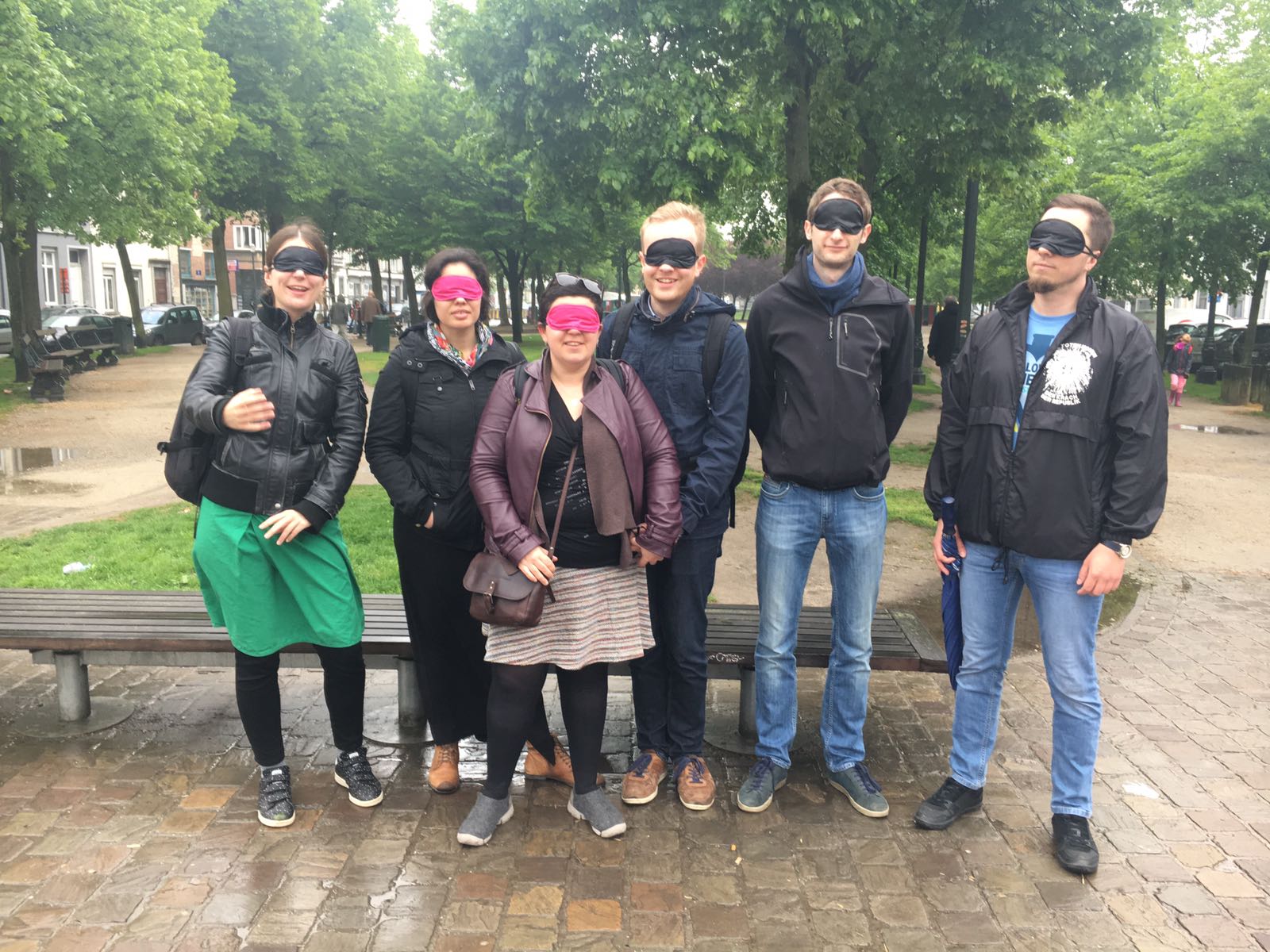In the context of the first ‘I love science festival’ that took place at BOZAR (Centre for Fine Arts) and Tour & Taxis, in Brussels, Belgium (27-29th April 2018); BOZAR Lab presented ‘When art meets science programme’ held at BOZAR. The series of sensory walks explored the consciousness of human senses in particular sound and smell in relation to the cityscapes and pedagogical techniques for schools and adults. The walks were repeating several times per day from one venue to the other, approximately 1 hour each; with younger participants on Fridays and adult audiences during the weekend.
The senses become a compass on BOZAR's Sensory Walks. Stéphane Marin introduced new ways of listening to spaces through his audio tours of the city. Sounds through the audience’s headphones merged with the natural noises in the background to transform the urban environment into a sonic landscape. While Stephane Marin explores the auditory aspect of the city, artist Klara Ravat explores the city's odours; stopping off in different locations to experience scents you would not normally notice. Do we all smell the same thing, or is it open to interpretation? Why our brains build a collective memory of a place and odour, and why every place develops its own highly personalised aroma?
Geographical maps are abstract and concrete at the same time for all objectivity of new measurements they cannot represent reality merely on the interpretation of it. Blurring from the actual to the imaginary maps can become subjective and mathematical patterns that define those journeys.
From sound mapping to scent topographies, maps can be subjective, public, political, psychological. On this project maps adopt a sensory perspective; that allows the participating audiences to experience alternative educational journeys, through an open & experiential approach that challenge experimental pedagogical methodologies and ways we experience cities.
"A culture is how specific people, in a specific place, in a specific moment, choose to portray themselves to each other and to the world. Artists are choosing to walk in order to regain control of our being from government officials, political parties, religions, corporations, and media. Artists are walking for you and me; artists are walking for us. Artists are trying to move away from the influence of competitive corporate culture that has increasingly defined art as an abrasive urban career. Artists are trying to replace this with the humbler notion of art as a practice, as a mindful way of life, consisting of consciously creative gestures, visible and invisible, large and small. Art practice is a private and public, selfless and generous, creative life process resulting in a conscious cultural product." (Ernesto Pujol, 2018)
Christiana Kazakou interviews the project’s walking artists for Interartive Magazine.
Listening to Spaces / Spaces of Listening: An interview with sound walking artist Stéphane Marin
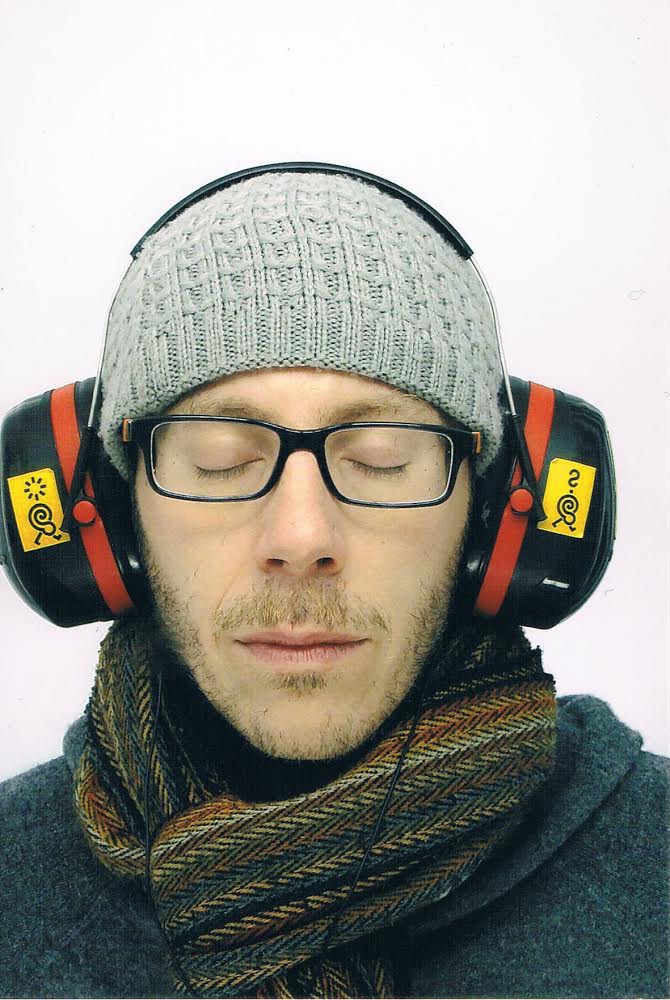
Photo credit © Stéphane Marin
In your sound walk practice in which ways the city integrates with environmental issues that transform the audiences walking experience?
My sound practice is rooted in in-situ listening. Whether is the city or other types of territories (countryside, protected natural area, park, garden, industrial space, architecture ...) I welcome them all with the same attention & openness to the encounter. In any way, I do not try to "integrate" (no more than dis_integrate!) a space (and those who are involved in) and I don’t want to "integrate" myself in it. What I must let happen - within the technicality of my own contextual practice - is space and time: an « opportunity », as open as possible to encourage the meeting between this territory and myself first, and then between this territory and the audience where the performance happens (the collective soundwalk). To check that there is still room for places (enough room) to impregnate the most strongly, the most specifically the creation in progress: a real opportunity to move it, to resonate in it, to inhabit it, to push its boundaries. Starting from an environment we will reveal together step by step: a landscape. Check that each site can be eligible (via a natural qualitative listening work, or mediated by a creation or a re-composition in situ) to the rank of landscape: this country re-created, transformed, « art_ialised » (as Alain Roger would say) by an act of creative consciousness (and / or sometimes perhaps also by the hazards of a Debors’ drift or a Bachelard’s « awakened reverie » ?!).
« City » must be heard as the medium of emergence of numerous sound streams, of varied dynamics, with fluid geographies, less constructed than the angles, defined by names of the streets which lead into quarters... This fluidity (but also the accidents and zones of rubbing or clogging, even breaking and then overflowing) has always been like an elemental premise in my artistic connection to the city. Mobility relates to, mobilities are related with their environmental / civic / political issues. And inevitably, their embarrassment, impediment, and their sharing, their co-existence. In the heart of mobility issues, are those in connection with the visually impaired which have nourished my approach the most deeply. Geographies (or even geo-phonies) shared by these people invite us to browse the spaces of our cities by the use of a more active listening, echo-located.
The city, this noisy space flows with vitality. In the baroque polyphony of our cities, I love to develop « temporary mobile listening zones » where the urban environment is no longer criticized as polluted but experienced as a unique wealth in view of the diversity of timbres, tones, details, all revealed to us by a less programmed, less intimidating, more welcoming listening... We would like to invite our « listening walkers" (Michel Chion) to experiment in the frame / the exercise / the experience of our listening.s walks.s, some zones of meetings, of tolerances, of benevolence to the glance (but especially to the listening) of the noises which, in the slow maturation of non-discriminatory active listening, will soon be transformed into sounds, and they will soon share with us their native musicality and their cinematic dramaturgy.
To what extent does technology challenge the pedagogical experience between audiences, places and sound?
In our case, considering the systematic use of phoNographic practice (ie a composition’s work initially linked to environmental sound recording) the microphone is the first artefact that gambles with / questions / disrupts / transforms the experience between the listener, the place and what it sounds like. Microphone "augmentation" is traditionally understood as "amplification". The gain made by the stages of signal amplification, the character of the microphones, the « grain » of the pre-amps, already inflict the signal an alteration. Then with the help of the recording a second mutation takes place. The listening experience becomes more and more « schizophonic » (Murray Shaefer), delivered from the source of the signal and the place of resonance: we then perceive more or less faithful traces of sound and place, their reflections, even their shadows…
Then comes the « re_COMPOSITION » time: treatments, mixing process, overlays, scrubs, makeup, polishing, sculpture of the sound, before to go back in-situ for a « superimposed » listening, in contact-filigrees, layers, underlays - with the real sounding. There, listening is put to the test of spaces and time (performance and/or walking), relocated (here or elsewhere?) re_temporalised (now, yesterday, tonight ??). The experience of reality, the audiences’ connection with places and sounds is mediated in-situ through the technological devices (microphones / amplifier-recorder / treatments / spread system / headphones) which enriches our perception of the places and our awareness to skim / browse them.
No one is certain anymore of what, where, from whom, how, he listens. The device has indeed an experiential pedagogical aim: at the heart of the radical questioning about the veracity of our perception, it teaches us to be more open to listening: to create a conscious space of emergence, expanded listening: maybe… « augmented ». It confirms that if we can always doubt about perceptions as such, but still continue to perceive here and now: "audio ergo sum" !
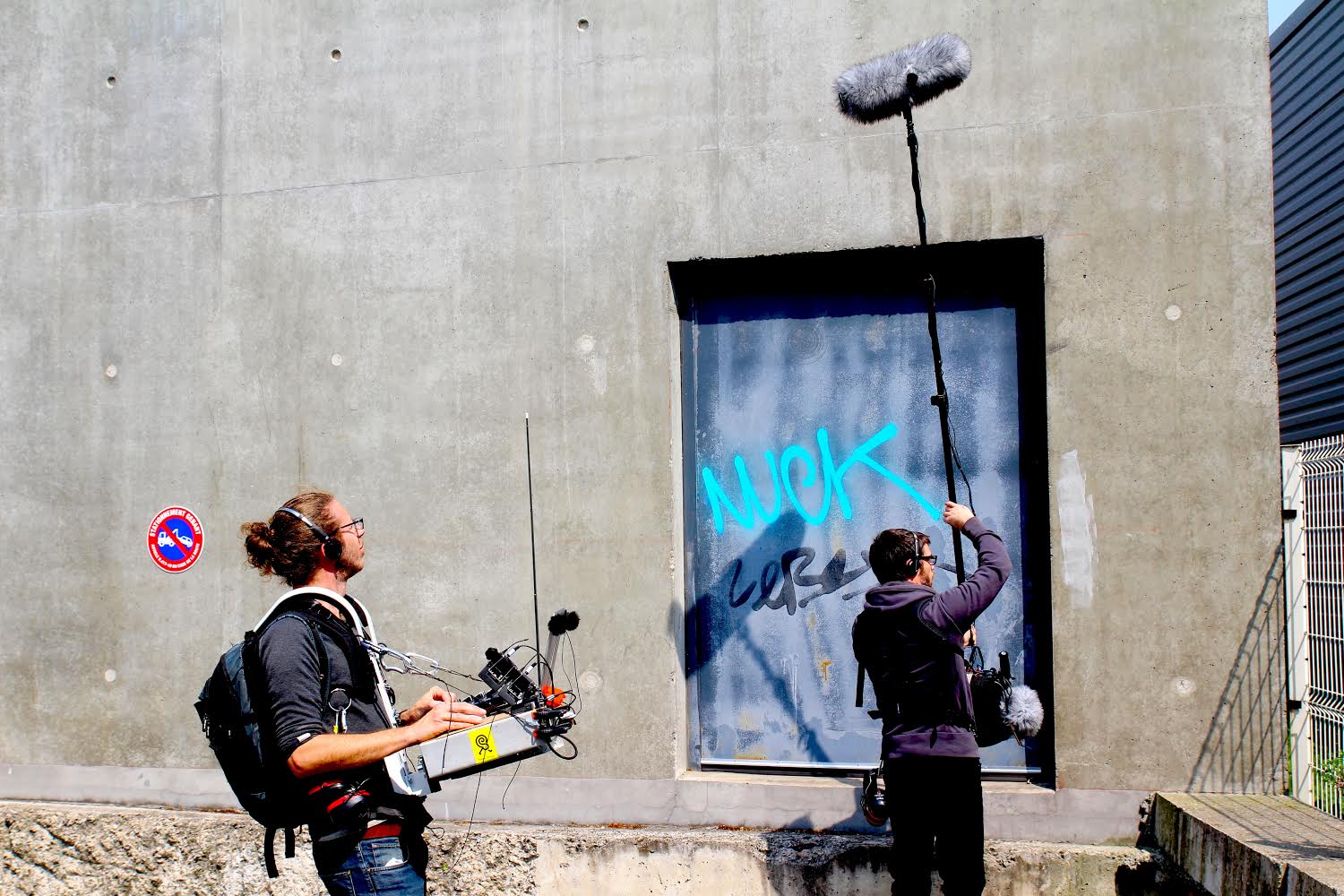
Photo Credit © Nathalie Dona
Which is the methodology you implement and what is the importance of improvisation in order to achieve an open-ended dialogue with the responsive environment?
When creating an augmented listening walk, firstly I create a path, a walk: what I call a « spaces’ score » (# 1). I choose, compose with these spaces in terms of their physicality, their "mood", their sequence, their own rhythms, and of course, their acoustic / sonic environments. At this stage, they must already, and by themselves, compose a coherent ensemble and respond to a maximum walking time (often a loop of one hour). In a second time (but this time of course started as soon as I arrived in situ ...) comes a "naked ears’ listening » (# 2). Here I could dive deeper into the sound dimension, the timbres, the acoustics, the resonances, the contrasts offered by these spaces. The sonic potential of the places thus felt, perceived, lived, travelled will begin to walk inside me. At this stage I can begin to develop a projection of what will be the walk, the course. But there is still an important step: "auscultation" (# 3): that is to say a time of research, tracking, investigation in the heart of the more or less audible sound material, even "inaudible" (with unamplified ears ...). It is at this moment, and not before, that I take my microphones and my recorders out in order to resort to an amplified listening which will be able to give place (or not) to recordings. Contact microphones, hydrophones, electromagnetic coil pickups sensors, help me hear (or even collect) inaudible or poorly audible sound. With these « invisible » sounds I would compose a soundtrack or I would choose to reveal their existence live, to enjoy their raw energy, their musicality, and to play with them. Finally, more "traditional" microphones will be used to isolate and / or amplify sound objects to detach them from their environment to make them to be heard in their purity, their simplicity: as soloists; or, with (native) binaural recordings which offer very realistic and immersive soundscapes that can compete in situ with the direct sound of the same place at another time (night / early morning, other weather ...) to create "ghosts", absent presences ... Back intramural, after listening to these sounds "acous(MA)tically", I will gradually finalize the writing of the course, validating / invalidating certain spaces, certain sounds, certain potentialities which, for structural and / or temporal reasons, cannot be part of this journey. Each portion of territory / place / zone will be associated with a sound proposition, a game, a mode of interaction, an experimentation, a posture and / or a listening device. These situations are created in-situ or are "drawn" into a pool of sound "legos" ("spaces / typical situations") that we have been experimenting with for several years (2010). The finesse and the relevance of the compositing of the march resides in the sequence, the rhythm and the relevance of the connections established between the sites and the sound propositions (and / or listening). The walk composition will be finalized when going back and forth between inside and outside, coming and going together between the sound / listening composition and the uncontrollable reality of spaces in situ.
After developing for nearly 10 years sound and listening walks using an audio player to broadcast recorded compositions, it is quite naturally - and in concert with the development of certain technologies - that in these last years (2012-2018), we created a live and in-situ re_COMPOSITION of the soundscape. « Re_COMPOSED re_ALITY » allows us to interact in vivo, in-situ, in real time with the different sounds streams, objects, actors, which make up the sound environment of the places. It is a singular and significant advance in the heart of our approach which allows us a greater reactivity and allows us to go even more radically, more sincerely, meeting the spaces and those who cross them. But, even if our device allows us today a more direct, instantaneous and reactive dialogue with the sound world, this work of improvisation should not overshadow our need of writing that overflows our desire to improvise: that's why « re_COMPOSED re_ALITY » was not called: « impro_VISED improb_ABILITY » …
In which ways psychogeography & psychoacoustics influence those journeys? How do the participants explore another aspect of their personalities through their exposure in science and public spaces?
Yes, this contextual, environmental, in situ approach has a link with psychogeography, in that it creates many kinds of « situations »: spaces’ experiences. Audible situations to form sensitive psychogeographies. Retain the links between the listener and the spaces visited, redefine its place in these demystified, desacralized, deritualized spaces, freed from their practical, functional, commercial aspects, from their agreed, imposed, sclerotic uses. To re-apprehend a territory only through its senses, sensibly, sensually, poetically, po-ethically. Not really like a "Drift" (Debors), our courses are too written to reflect this freedom of wandering there. But as long as « the psychogeography is interested " in the perception of the urban space, and more particularly to the affective experience of the space by the individual " » then yes, in that sense, our soundwalks are part of a psychogeographical perspective, and why not even "psychogeophonic"?
Concerning psychoacoustics, it is like the soil in which we germinate our listening’ seeds. Like the specimen in which we mix our sound solutions in-situ. The use of binaural recording, the work of perceptual disturbance, trompe-l'oeil, over- or hyper-realism, our desire to increase certain imbalances, to create vertigo come naturally from the fields of psychoacoustics (which we don’t know anything about, except perhaps some cooking sound recipes ... - but we recognize this place as a diffuse point where is anchored our approach). We practice (with the tacit agreement of the listener) some very unscientific experiences where sound stimuli generate, arouse, (dis-)guide other sensations in the heart of a walk in public spaces. These are seen to be transmute from / by listening.
One could certainly affirm that, by the practice of some experiments on psychoacoustics, one tries to free the listener from a too utilitarian vision (listening) of the walked spaces in order to open in those a privileged access (slightly marked) for open the door / to create some access / to finally deploy your own psychogeography in the heart of the soundscape.
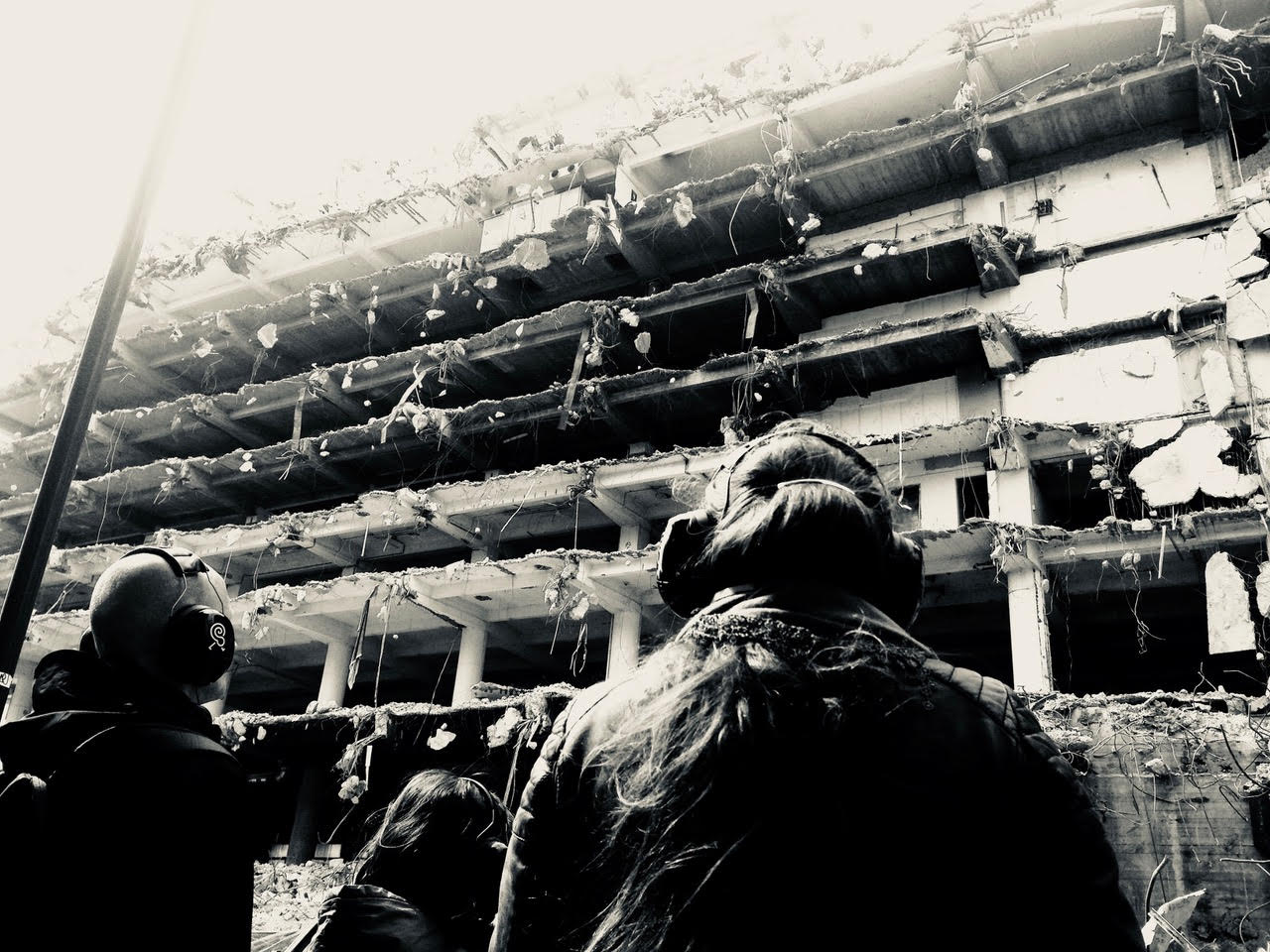
Photo Credit © Stéphane Marin - Espaces Sonores
How does technology affects the experience of the walk-through augmentation, perception and alternative states of reality?
The use of technology must be understood here in terms of devices. Let's start with the end (which is the beginning of the chain for the listener ...) ie: the headphones. The use of headphones in our work should not be understood as a media to broadcast an ex nihilo (in vitro) creation. But first and foremost the means of soliciting environmental listening "through" the helmet, then by extension (pedagogical? maybe… experientially! certainly!), in finality: the « frame » of any landscape. That the headphone is "open" and very porous to the reality, inviting the sound environment in filigree, sub-tilably, in the heart of the listening and / or the creation (by means of a pre-recorded sound track or an improvised live). Or, if it is very closed - like our noise-cancelling headphones (-36 dB) - the sonic reality becomes a visual frame which we can at leisure (and almost to infinity) re_COMPOSE the perspective, correct the dynamics, amplify-attenuate / reverse / alterate the flows ... It is thus necessary to understand the headphones as the point of contact (and no longer as an obstacle) between the ear, the real sound and the audio stream of the creation / performance.
This "artistic" flow, whether re_composed in studio (in vitro) or improvised (in vivo) - according to Michel Risse’s (Décor Sonore) terminology - is "podcasted" (via audio player), "streamed" (via web feed) or "broadcasted" (via radio), directly into and in contact with the dedicated spaces for which it was created / performed, the dedicated place where they should be listened. The propositions are (hyper-) contextual, as soon as they put in relation, in perspective, in resonance, in play, in tension, ... in experience, the listening and the spaces in the heart of reality. The modification, (the « augmentation » ???), of the listening (which sometimes require a "diminution" of the listening frame ...) can take several appearances: just as much operated by frequence filtering, of remote, zooms, lures, dis- or trans-phonies, by fantasy acoustic generation ...
In any case, these altered and synaesthetic perceptual states lead to another practice, to another mode of sharing and to « being-there » in these transmuted, mutated (public) spaces, but for all, and perhaps always, a little more real?!. Much more than a simple "decor", the reality (the environment) is here a stepping stone to more presence and consciousness (even if often the vector of reverie, or elemental transmutation could make us believe that this new perception of reality would abstract it, virtualizing it…). Hide, masked to better reveal. Remove, erase, a few moments, to better elevate, highlight, put in perspective over a longer term ... Disorientate (even stun) to finally better situate, in his (own) body and (his) full consciousness, there: here and now.
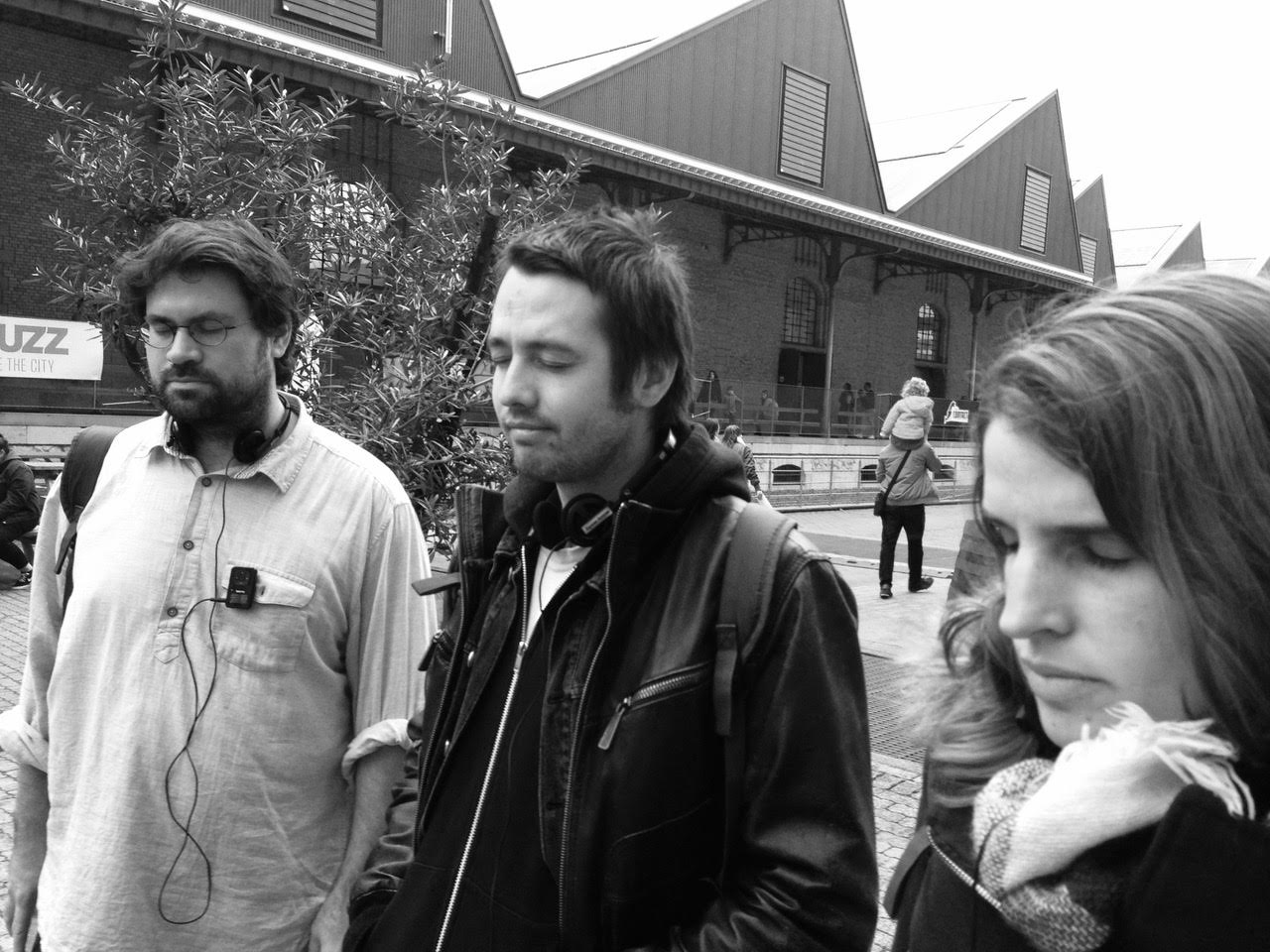
Photo Credit © Stéphane Marin - Espaces Sonores
Exploratory Scent Walks: An interview with artist Klara Ravat
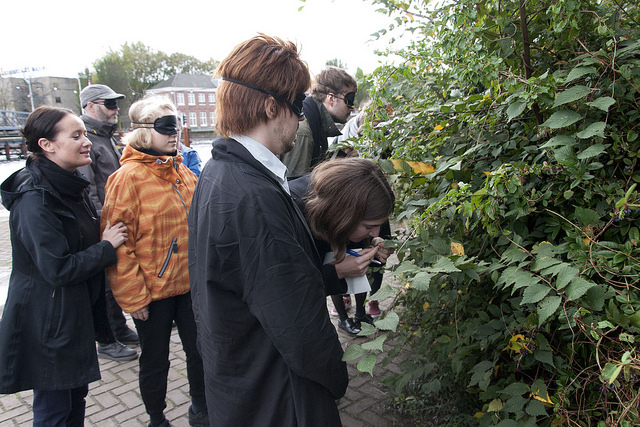
Photo Credit © Klara Ravat, Mediamatic
How does your scent walking practice relate to the senses and the participating audiences?
My walking practice in smell walk format relates to olfaction and how we smell. Walking is not only a mean of transport, or a trajectory between two points, nor the path you need to follow to your job or school every morning. Walking is a rooting and meditative exercise.
It doesn't necessarily have to mean anything, it can be only wondering or boredom.
Walking moves all your muscles and bones in your body, therefore also your brain becomes active. It relaxes us and allows us to find clarity in our thoughts.
Such an activity can bring all our senses together, which makes us feel more connected to our environment and world around us. That's what I try to bring out from the participants, a time to focus on a small thing, our nose. And through this focus make people feel relieved, trust one another and have a break.
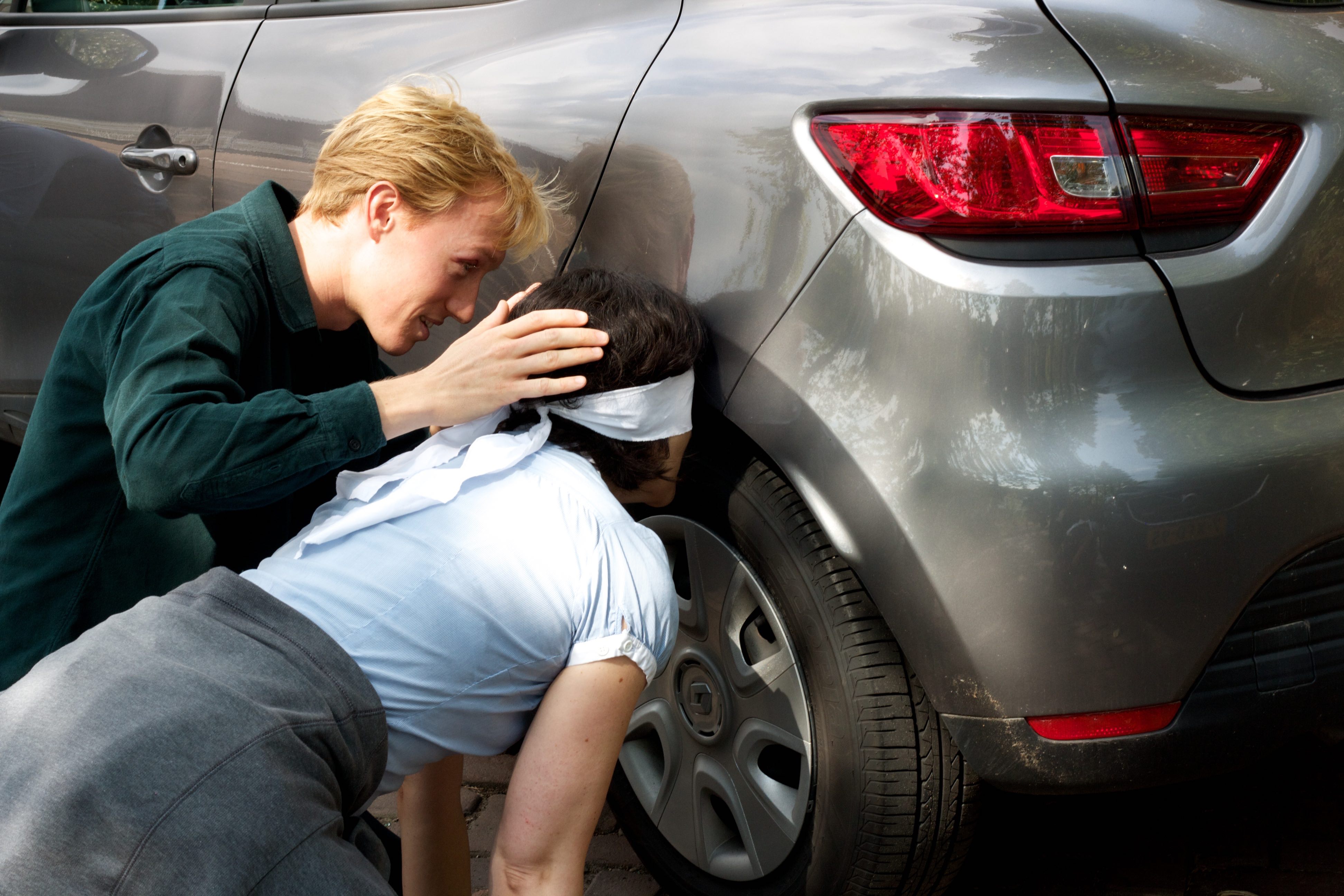
Photo Credit © Klara Ravat, Mediamatic
Does the audience experience scent on a subjective or public means and which is the importance of engagement during the walks?
During the walks, participants are asked to team up in pairs. One will lead the other, the other being eye folded. I help the group guiding the navigation of the walk.
I choose spots in the city that are playful to smell. And depending on how the group is functioning we do around where the participants choose where to bring their partners in crime.
So there are different levels of engagement, but all of them very important. I don't think to look or only walking close to the smell walk group would bring you out any inputs. You really need to take part in it.
Anyhow, back to smelling, the participants aren't aware what are they smelling, they aren't allowed to see it nor touch it, only sniffing. The guides are also given instructions not to talk about what the smellers are putting their nose into.
This way smelling becomes pure, out of any judgment, not allowing any other sense to interfere. Brings us to create subjective interpretations of the public space.
Photo Credit © Christiana Kazakou
Which are the contributions to the pedagogical methodologies as well as experiential learning in your view?
I believe that after the guided smell walk, participants become way more alert on the scent in the city, questioning how things might smell like, and why did they never think about it before. This experience is designed to be an eye-opener, how something so simple can trigger so many thoughts? This way the contribution to pedagogical methodologies is experimental, the smell walk wants you to wonder, experiment and learn on the way. At the same time, this wonderment generates a powerful reflection. And not only that, during the walk there is a need of one person taking care of another, most of the times someone they have just met for the first time. Then we have a powerful trust/connecting tool!
How does smell interfere with science and which is the outcome of those interactions?
“Smell” as itself is a very broad term. I would say that from one side, the odorants, we perceive while walking and sticking our noses to objects and vegetation in the urban environments, related to science in a very direct way, they are molecules that we perceive, and will be connected to our smell receptors in our noses, and most probably will send a signal to our brains. But to give another example, scent mappers like Kate Mclean, have been mapping pollution trails in cities like Barcelona. Scent can give us so much information on the air state or if a plant is healthy or even a person. Scent is all about communication between things and persons, persons and animals, animals and nature, and so on.
During the sensory journey, do the participants create a personal mapping based on their perception, site specification, and public art practice? How do scent walks affect collective and subjective memory? And in which ways do audiences create their own narrative through this experience?
There are people with a very well-trained sense of smell because they are very sensitive or developed further skills. So we have the participants that create their personal mapping, through associations, recovering memories or talking to the other participants but there are also the participants who are very good at detecting what is the source of the smell. For example, when smelling a trash bin, often the smellers describe the content of the trash in it, coffee, food, rotten fruits, fermentation... but they can't think off a trash smelling so delicious. In that way, there are building a very subjective map in their brains throughout their own interpretations of the place.
Also, scent can be so distinctive, an area of a city can be recognized by its aroma or stink. When in your city you know which streets to take and which ones to avoid. In the same way, during the walks, there is always a discussion, where participants share their interpretations. How intense was the scent, what did they think it was, could they describe it and how different did they smelled it, and so on. At that point, there is a shared interpretation of the scents, which will indeed create a collective.
Photo Credit © Christiana Kazakou
Both artists create their own walking manifestos; developing enchanting dialogues between art & science; neuroscience, cognitive psychology, technology and space. Their walking practises & experiential psychogeographical field journals engage the participants in multiple layers; they become social choreographers and cultural activists merging themselves in intimate insights and the neuroscience of our senses. The exploratory process is making the audiences rethink what it means to walk and discover different ways in which to walk as a radical practice and reconsider how to attend to the inner and outer landscape whilst walking. Finally the practices reflect on socially engaged paths, collective & subjective experience and interdisciplinary pedagogical methodologies that have the capacity to alter our data for perception.
Through our senses ‘our relationships with cities are like our relationship with people. We love them hate them or are indifferent to them’
Victor Burgin
--
For further information on the project please see the following websites:
When art meets science, BOZAR Lab
Artists' websites: http://www.espaces-sonores.com / https://vimeo.com/250114825 / https://www.klararavat.com

